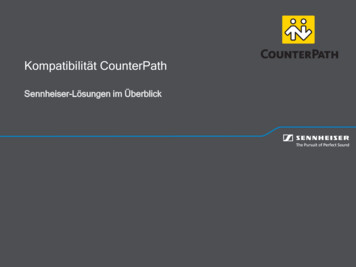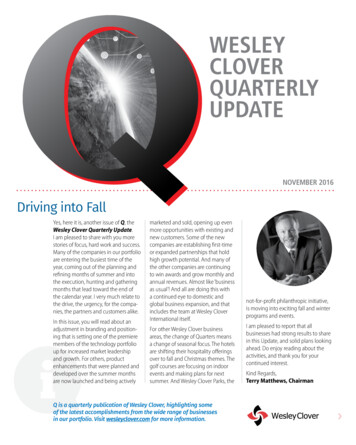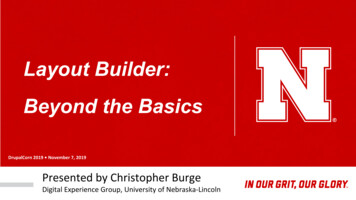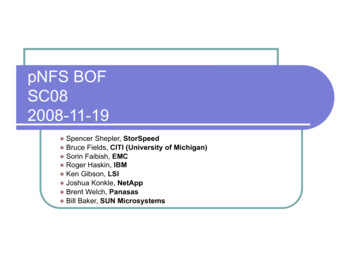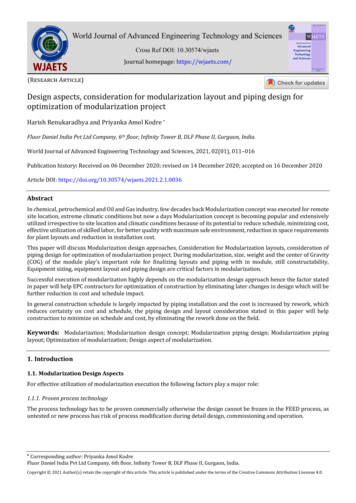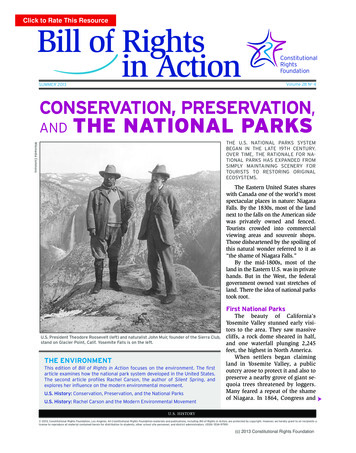
Transcription
bria 28 4:Layout 14/19/20133:55 PMPage 1Click to Rate This ResourceBill of Rightsin ActionConstitutionalRightsFoundationSUMMER 2013Volume 28 No 4CONSERVATION, PRESERVATION,ANDTHE NATIONAL PARKSWikimedia CommonsTHE U.S. NATIONAL PARKS SYSTEMBEGAN IN THE LATE 19TH CENTURY.OVER TIME, THE RATIONALE FOR NATIONAL PARKS HAS EXPANDED FROMSIMPLY MAINTAINING SCENERY FORTOURISTS TO RESTORING ORIGINALECOSYSTEMS.The Eastern United States shareswith Canada one of the world’s mostspectacular places in nature: NiagaraFalls. By the 1830s, most of the landnext to the falls on the American sidewas privately owned and fenced.Tourists crowded into commercialviewing areas and souvenir shops.Those disheartened by the spoiling ofthis natural wonder referred to it as“the shame of Niagara Falls.”By the mid-1800s, most of theland in the Eastern U.S. was in privatehands. But in the West, the federalgovernment owned vast stretches ofland. There the idea of national parkstook root.First National ParksU.S. President Theodore Roosevelt (left) and naturalist John Muir, founder of the Sierra Club,stand on Glacier Point, Calif. Yosemite Falls is on the left.THE ENVIRONMENTThis edition of Bill of Rights in Action focuses on the environment. The firstarticle examines how the national park system developed in the United States.The second article profiles Rachel Carson, the author of Silent Spring, andexplores her influence on the modern environmental movement.U.S. History: Conservation, Preservation, and the National ParksU.S. History: Rachel Carson and the Modern Environmental MovementThe beauty of California’sYosemite Valley stunned early visitors to the area. They saw massivecliffs, a rock dome sheared in half,and one waterfall plunging 2,245feet, the highest in North America.When settlers began claimingland in Yosemite Valley, a publicoutcry arose to protect it and also topreserve a nearby grove of giant sequoia trees threatened by loggers.Many feared a repeat of the shameof Niagara. In 1864, Congress andU.S. HISTORY 2013, Constitutional Rights Foundation, Los Angeles. All Constitutional Rights Foundation materials and publications, including Bill of Rights in Action, are protected by copyright. However, we hereby grant to all recipients alicense to reproduce all material contained herein for distribution to students, other school site personnel, and district administrators. (ISSN: 1534-9799)(c) 2013 Constitutional Rights Foundation
bria 28 4:Layout 14/19/20133:55 PMPage 2President Abraham Lincoln enacted a law that handed Yosemiteover to California to manage as astate park for “public use, resort,and recreation.”In 1868, John Muir arrived inCalifornia. An expert on plants whohad hiked many wilderness areas inthe U.S., he discovered the wondersof Yosemite. Muir published articleson his spiritual experiences in thewilderness and also wrote scientificpapers. Contradicting most geologists, he argued correctly that glaciers had formed the YosemiteValley. His fame as a naturalistspread throughout the U.S.Yosemite did not become America’s first national park. That honorwent to Yellowstone, locatedmainly in northwest Wyoming.Reports of Yellowstone’s regularly erupting water geysers, steaming rivers, and bubbling mud poolshad been dismissed as “Yellowstone hallucinations” for manyyears. Finally, a U.S. governmentexpedition led by geologist Ferdinand Hayden in 1871 documentedthese fantastic features and more.Hayden became the leading advocate for Congress to preserve Yellowstone as a national park. Hewarned against business interestsplanning to enter Yellowstone “tofence in these rare wonders so asto charge visitors a fee as is nowdone at Niagara Falls.”During the debate in Congressover creating Yellowstone NationalPark, many had to be convincedthat the federal public land involved was useless for homesteading,farming,ranching,mining, lumbering, or other economic purposes. For them, publiclands were meant to be sold orleased for settlement and their resources. Hayden argued that Yellowstone’s high altitude, harshclimate, and poor soil made it“worthless lands” except for theirscenery and natural wonders.2In 1872, Congress and PresidentUlysses Grant made Yellowstonethe first national park — not onlyin the U.S., but in the world. Thelaw set aside 3,500 square miles offederal land as “a public park orpleasuring ground for the benefitand enjoyment of the people.”Meanwhile, John Muir was lobbying for Yosemite to be returnedto federal control and made a national park. He made the same“worthless lands” argument thatHayden had used for Yellowstone.In 1890, Congress created threeCalifornia national parks. The Sequoia and General Grant (laterKing’s Canyon) parks protectedgroves of giant redwoods. YosemiteNational Park included mountainand forest areas but not the spectacular Yosemite Valley or nearbyMariposa Grove of sequoias. Theyremained in California’s hands.Disappointed, Muir founded theSierra Club, in part to work towardincluding these jewels of naturewithin the park.When settlers beganclaiming land in YosemiteValley, a public outcryarose to protect it andalso to preserve a nearbygrove of giant sequoiatrees threatenedby loggers.In 1887, Theodore Roosevelt,then a federal civil servant, helpedorganize the Boone and CrockettClub. Originally for rich big gamehunters, the club supported the creation of national parks as essentialrefuges for endangered wildlife. Theclub took up the cause of saving asmall herd of the vanishing buffaloin Yellowstone National Park.Roosevelt lobbied Congress topass the Yellowstone Game Protection Act of 1894, which strengthened enforcement of laws againstillegal hunting in the park. This expanded the rationale for nationalparks beyond protecting scenery toalso protecting wildlife.Saving the WildernessTheodore Roosevelt had been asickly child, but had relied onwillpower to force himself tobecome, in his word, “manly.” Hehunted, fished, hiked, and embraced the outdoor life. After graduating from Harvard, he traveledthroughout the West and started aranch in North Dakota.In 1890, the U.S. Census Bureau announced the West had beenlargely settled and the frontier hadcome to an end. This got Rooseveltthinking about the importance ofholding on to what was left ofAmerica’s wilderness.WhenPresidentWilliamMcKinley was assassinated in 1901,Vice President Roosevelt movedinto the White House. His topwilderness priority was to makeArizona’s Grand Canyon a nationalpark. But fierce opposition fromlocal miners, ranchers, loggers, andtourist businesses killed his proposal in Congress.In 1903, Roosevelt toured theWest by train. At the GrandCanyon, he pleaded with Arizonans to “keep this great wonder ofnature as it now is.” He then visited California and joined JohnMuir in a campout under the starsat Yosemite. Muir spent his timewith Roosevelt arguing for the return of the Yosemite Valley andMariposa Grove of giant trees tofederal control as part of YosemiteNational Park.In 1906, Roosevelt persuadedCongress to include the Yosemite Valley and Mariposa Grove within parkboundaries. But he grew frustratedU. S. HISTORY(c) 2013 Constitutional Rights Foundation
4/19/20133:56 PMPage 3by how long it took Congress to actand to approve new national parkshe wanted like Grand Canyon.Congressman John F. Lacy (RIowa) became an ally of Roosevelt.A supporter of protecting cliffdwellings and other ruins of theancient southwest pueblo people,he designed a bill modeled after an1871 law that had given the president the power to create nationalforests on his own. The AntiquitiesAct of 1906 gave the president theauthority to protect “historic landmarks, historic preservation structures, and other objects of scientificinterest” on public land as nationalmonuments.The Antiquities Act proved tobe just the legal tool Rooseveltneeded to bypass Congress andspeed up the protection of America’s natural and man-made heritage. Within a year, he createdseven national monuments by executive order such as New Mexico’s Chaco Canyon, the largestU.S. archaeological site of ancientpueblo ruins.Then, in 1908, Roosevelt declared Grand Canyon an “object ofunusual scientific interest” andmade it a national monument.Shortly after he did this, Rooseveltappealed to Americans that placeslike Grand Canyon should be “preserved for their children and theirchildren’s children forever, withtheir majestic beauty all unmarred.”Before Congress realized it,Roosevelt was using the AntiquitiesAct to protect natural and historicsites from private exploitationwhile awaiting full national parkprotection. Under the AntiquitiesAct, the rationale for national parksagain expanded to include protection for places with historic andscientific importance.In the last months of his secondterm, Roosevelt went on a frenzy,using his executive powers to createNational Park Servicebria 28 4:Layout 1A park ranger atop his car, c. 1935, keeps an eye on a herd of bison.or expand national monuments, national forests, game preserves, andbird reservations. Altogether, he leftan astounding legacy: five nationalparks, 18 national monuments, 150national forests (created or enlarged), 51 bird reservations, andfour national game preserves.Conservation vs. PreservationIn 1905, President Roosevelthad put Gifford Pinchot in chargeof the new U.S. Forest Service,which took over management ofthe national forests. Pinchot hadstudied forestry at Yale and in Europe and was America’s first professional forest expert.In 1907, Pinchot proposed theword “conservation” to describeRoosevelt’s wilderness protectioncampaign. Pinchot believed, andRoosevelt agreed, that federallands, even national parks, shouldbe useful by giving up valuable resources when needed. In fact, thishad always been the prevailingview in Congress when nationalparks were proposed.Preservationists like John Muir,however, thought that mountains,forests, and other wild placesshould be left alone. He defendedthe usefulness of national parks ina different way:Thousands of tired, nerveshaken, over-civilized peopleare beginning to find out thatgoing to the mountains is goingU. S. HISTORYhome, that wildness is a necessity, and that mountain parksand reservations are useful notonly as fountains of timber andirrigating rivers, but as fountains of life.Pinchot and Muir becamefriends and allies during numeroustrips in the West. But they clashedbitterly when San Francisco proposed to dam the river runningthrough the Hetch Hetchy Valley ofYosemite National Park in order tocreate a city water reservoir.Preservationists like Muir described Hetch Hetchy as almost atwin to the magnificent YosemiteValley. But unlike it, Hetch Hetchywas a truly wild place not yetspoiled by tourism. Preservationistsfeared that if the Hetch Hetchy damwas built, all the national parkscould be threatened by demandsfor their resources.Conservationist Pinchot backedSan Francisco, arguing that national parks should be used to benefit the people. Many asked whyscenery should be more importantthan the growing needs of a city.Both sides appealed to President Roosevelt. In the end, he supported his trusted adviser Pinchotover his friend Muir. The fightdragged on until 1913 when President Woodrow Wilson signed thelaw that approved construction ofthe dam.3(c) 2013 Constitutional Rights Foundation
bria 28 4:Layout 14/19/20133:56 PMPage 4National Park Serviceabout such things as fighting allfires in the parks and removingpredators like wolves. He concluded that park environments andwildlife should be largely left aloneto take their natural course withoutinterference from humans.In 1933, Wright was appointedto head a new NPS wildlife division. He immediately began to hirebiologists to work on habitat protection. Tragically, he was killed inan auto crash two years later, andthe NPS lost interest in his ideas.Restoring EcosystemsVisitors to Cuyahoga Valley National Park (in Ohio) learn from a park ranger.The National Park ServiceWell into the 20th century, thenational parks had no single federal agency to manage them. Responsibility was split among theDepartment of the Interior, the Forest Service, and the War Department, which sent cavalry units tobuild roads and guard against illegal hunting.After their Hetch Hetchy defeat,preservationists began to lobby for anew government agency dedicatedto protecting and promoting the national parks. The preservationistsgained an unexpected ally in politically powerful railroads that wantedto transport tourists to the parks.In 1916, Congress establishedthe National Park Service (NPS). Itsmission was to maintain the national parks for the “enjoyment” ofthe people while leaving the parks“unimpaired” for future generations. But how could the NPS bothcater to tourist enjoyment and keepthe parks unimpaired and natural?Stephen Mather, the first NPSdirector, adopted policies heavilyon the enjoyment side. Heworked to make the national4parks self-supporting by promoting tourism. He encouraged parkhotels built by the railroads, roadsfor automobile access, and privateconcessions like restaurants andtourist cabins. He supported parktourist attractions like the giant sequoia with a car tunnel, bear feeding shows, and Yosemite’s “firefall”where a stream of burning emberswere dropped at night from GlacierPoint to the valley far below.Mather also introduced parkrangers and championed new national parks such as Alaska’sMount McKinley, Hawaii Volcanoes, and Arcadia in Maine, thefirst park created east of the Mississippi. In 1919, he helped getCongress to finally upgrade GrandCanyon to a national park.In the late 1920s, GeorgeWright, a young naturalist atYosemite National Park, began topublicly question NPS policies thatmainly focused on tourism. Hepointed to the other NPS mission toleave the parks unimpaired for future generations.Wright conducted studies thatcontradicted long-held NPS ideasAfter World War II, with the dramatic expansion of the nationalhighway system, national parks became more popular than ever. Overcrowding led to demands for moreroads and visitor facilities. Butpreservationists began to argue asGeorge Wright did that healthy parkecosystems were more importantthan additional parking lots.In 1963, a team of scientistsstudied NPS wildlife managementpolicies. The scientists recommended restoring park ecosystemsas much as possible back to theiroriginal natural condition. Congressresponded to this new thinking bypassing the Wilderness Act of 1964.Wilderness areas established withinnational parks and other protectedareas were to remain wild withoutroads or motorized vehicles.Following Alaska statehood in1959, a major battle erupted amongthe state’s residents, native peoples,commercial interests, and preservationists over the distribution of millions of acres of federal land. Much ofit was untouched by humans andteeming with wildlife. The preservationists saw Alaska as their lastchance to get wilderness protectionright. Others saw it as a storehouse ofnatural resources like oil to be tapped.After a decade of debate, Congress passed a compromise act thatPresident Jimmy Carter signed inU. S. HISTORY(c) 2013 Constitutional Rights Foundation
bria 28 4:Layout 14/19/20133:56 PMPage 51980. The law created new nationalforests, wildlife refuges, wildernesspreserves, and seven new nationalparks. This was the single largestexpansion of protected land inworld history. It more than doubledthe national park system.The current rationale for nationalparks has expanded again. It nowincludes restoring, where possible,original ecosystems. In 1967, theNPS reversed its long-held policy ofsuppressing all fires in the parks because natural fires are necessary toclear space for new growth and forcertain tree seeds to germinate. In1995, wolves were reintroduced intoYellowstone to restore nature’s wayof weeding out weak animals andreducing overpopulated elk herds.For nearly 150 years, the rationale for national parks expanded fromsimply preserving scenery to protecting wildlife, objects of historicaland scientific value, endangered environments, and wilderness areas.Today, the rationale goes beyondprotection to restoration of originalpark ecosystems.The national park system nowincludes 59 national parks and 76national monuments. The NPS alsomanages or helps to administer 263historic parks and sites, battlefields, wildlife refuges, seashores,lake shores, wild rivers, trails, andother special places.President Theodore Rooseveltdeclared Pinnacles, an area of unusual rock formations in centralCalifornia, a national monument in1908. More than 100 years later,President Barack Obama signed thelaw making it the newest nationalpark in 2013.Writer and environmentalistWallace Stegner once said, “Nationalparks are the best idea we everhad.” Evidence of this is thatmore than 100 nations havecopied our national park idea toestablish some 1,200 parks andpreserves of their own.For Further ReadingDuncan, Dayton. The National Parks:America’s Best Idea. New York: AlfredA. Knopf, 2009. [This is the companion book to Ken Burns’s television series of the same title.]Runte, Alfred. National Parks: TheAmerican Experience. 4th ed. Lanham, Md.: Taylor Trade Publishing, 2010.DISCUSSION & WRITING1. What is the difference between“conservation” and “preservation”as championed by Gifford Pinchotand John Muir? Whose view doyou agree with more? Why?2. Do you agree with PresidentTheodore Roosevelt’s decisionto back the building of a dam inYosemite’s Hetch Hetchy Valley? Explain.3. The National Park Service has twosomewhat contradictory missions:to provide for the people’s “enjoyment” of the national parks and toleave them “unimpaired.” Whichmission do you think is more important? IVITYNational Park System DilemmasMuch controversy surrounds today’s national park system policieson preserving and restoring original ecosystem conditions. Form smallgroups. Each group should discuss and decide one of the followingdilemmas. Each group will then report and defend its decision.1. Lightning has ignited a forest in Yosemite National Park. Some wantto let the fire naturally burn itself out. But this will scar the sceneryfor a decade or more, destroy many animals, and possibly threatencommunities outside the park. What should park authorities do?2. Wolves have been reintroduced in Yellowstone National Park. Thestate of Wyoming has set a limit on the number of wolves huntersmay kill outside the park each year. After the limit is reached,should ranchers near the park be allowed to kill a wolf that isthreatening livestock?3. An elk has broken through the ice on a lake in Grand Teton National Park. The elk is weakening and will soon drown. Nearby isan NPS ranger with his vehicle that has a winch and rope. Whatshould the ranger do?4. The Arctic National Wildlife Refuge along Alaska’s northern coastis the largest protected wilderness in the U.S. Congress delayeddeciding whether to permit oil drilling in Area 1002, making upless than 10 percent of the refuge. Supporters say drilling isneeded to reduce U.S. dependence on foreign oil and keep gasprices from going too high. Opponents say that drilling sites,roads, pipelines and possible oil spills will harm the primitiveecosystem of Area 1002, which includes a birthing ground for caribou. What should Congress do?5 In 2010, Congress and President Obama lifted the federal ban onvisitors carrying concealed and loaded guns into the nationalparks. Those in favor cited the need for self-defense and SecondAmendment rights. Those against warned about shooting atwildlife, illegal hunting, and park vandalism. As potential visitorsto national parks, what is your view?U. S. HISTORY5(c) 2013 Constitutional Rights Foundation
bria 28 4:Layout 14/19/20133:56 PMPage 10SourcesStandards AddressedNational ParksNational Parks“A Brief History of Pinnacles National Park.” KCET. 16 Jan. 2013.URL: www.kcet.org · Brinkley, Douglas. The Wilderness Warrior:Theodore Roosevelt and the Crusade for America. NY: Harper, 2009.· “Call of the Wild.” The Economist. 22 Dec. 2012. · Duncan, Dayton. The National Parks: America’s Best Idea. NY: Alfred A. Knopf,2009. [This is the companion book to the Ken Burns TV series bythe same title.] · . “Pinnacles — It’s a Good Start.” LA Times.10 Feb. 2013. · Egan, Timothy. The Big Burn: Teddy Roosevelt andthe Fire that Saved America. Boston: Mariner Books, 2009. · Heacox, Kim. An American Idea: The Making of the National Parks.Washington, D.C.: National Geographic, 2001. · Lowry, Wm. Repairing Paradise: The Restoration of Nature in America’s NationalParks. Washington, D.C.: Brookings Inst. P, 2009. · National ParkService. U.S. Department of the Interior. 25 Jan. 2013. URL:www.nps.gov · O’Keefe, Ed. “Federal Government to Lift Restrictions on Guns in the National Parks.” The Washington Post. 19 Feb.2010. URL: www.washingtonpost.com · Runte, Alfred. NationalParks: The American Experience. 4th ed. Langham, Md.: TaylorTrade Publishing, 2010. · Wikipedia articles on “Arctic RefugeDrilling Controversy,” “History of the Yosemite Area,” “NationalPark,” “Yellowstone National Park.” URL: http://en.wikipedia.orgNational High School U.S. History Standard 20: Understands how Progressives and others addressed problems of industrial capitalism, urbanization,and political corruption. (2) Understands major social and political issuesRachel CarsonCarson, Rachel. Silent Spring. Boston: Houghton Mifflin, 1962. ·Griswold, E. “How ‘Silent Spring’ Ignited the Environmental Movement.” NY Times. 21 Sept. 2012. · Kline, Benjamin. First Along theRiver: A Brief History of the U. S. Environmental Movement. 4th ed.Lanham, Md.: Rowman & Littlefield, 2011. · Koehn, Nancy F.“From Calm Leadership, Lasting Change.” NY Times. 17 Oct. 2012.· Lear, Linda. Rachel Carson, Witness for Nature. NY: Henry Holt,1997. · Levine, Ellen. Rachel Carson. NY: Viking, 2007. · Lytle,Mark Hamilton. The Gentle Subversive: Rachel Carson, SilentSpring, and the Rise of the Environmental Movement. NY: OxfordU P, 2007. · Magoc, Chris J. Chronology of Americans and the Environment. Santa Barbara, Calif.: ABC-CLIO, 2011. · Meiners, Roger.“Silent Spring at 50: The False Crisis of Rachel Carson (Reassessing environmentalism’s fateful turn from science to advocacy).” 21Sept. 2012. Master Resource. URL: www.masteresource.org ·Neimark, Peninah and Mott, Peter Rhoades, eds. The Environmental Debate: A Documentary History. Westport, Conn.: Greenwood P, 1999. · Souder, William. “Rachel Carson Didn’t KillMillions of Africans.” Slate. 4 Sept. 2012. URL: www.slate.com ·Shabecoff, Philip. A Fierce Green Fire: The American Environmental Movement. Washington, D.C.: Island P, 2003. · “StockholmConvention on Persistent Organic Pollutants (POPs).” URL:www.pops.int/documents/ddt/default.htm · Wikipedia articles on“DDT” and “Environmental Impact of Pesticides.” URL:http://en.wikipedia.orgof the Progressive era (e.g., . . . the Hetch Hetchy controversy).National High School Civics Standard 23: Understands the impact of significant political and nonpolitical developments on the United States and othernations. (5) Understands historical and contemporary responses of theAmerican government to demographic and environmental changes thataffect the United States.California History /Social Science Standard 11.2: Students analyze the relationship among the rise of industrialization, large-scale rural-to-urban migration, and massive immigration from Southern and Eastern Europe. (9)Understand the effect of political programs and activities of the Progressives (e.g., federal regulation of railroad transport, Children’s Bureau, the Sixteenth Amendment, Theodore Roosevelt, Hiram Johnson).California History /Social Science Standard 11.11 Students analyze the majorsocial problems and domestic policy issues in contemporary American society.(5) Trace the impact of, need for, and controversies associated with environmental conservation, expansion of the national park system . . . .California History /Social Science Standard 12.7: Students analyze and compare the powers and procedures of the national, state, tribal, and local governments. (5) Explain how public policy is formed, including the settingof the public agenda and implementation of it through regulations andexecutive orders.Common Core Standard SL.11–12.4: Present information, findings, and supporting evidence, conveying a clear and distinct perspective, such that listenerscan follow the line of reasoning, alternative or opposing perspectives are addressed, and the organization, development, substance, and style are appropriate to purpose, audience, and a range of formal and informal tasks.Rachel CarsonNational High School U.S. History Standard 26: Understands the economicboom and social transformation of post- World War II United States. (1) Un-derstands scientific and technological developments in America afterWorld War II . . . .National High School U.S. History Standard 30: Understands developments inforeign policy and domestic politics between the Nixon and Clinton presidencies. (1) Understands how the Nixon, Ford, and Carter administrationsdealt with major domestic issues . . . .California History /Social Science Standard 11.8: Students analyze the economic boom and social transformation of post-World War II America. (6) Dis-cuss the diverse environmental regions of North America, theirrelationship to local economies, and the origins and prospects of environmental problems in those regions.California History /Social Science Standard 11.11: Students analyze the majorsocial problems and domestic policy issues in contemporary American Society. (2) Discuss the significant domestic policy speeches of [presidents](e.g., with regard to . . . environmental policy). (5) Trace the impact of,need for, and controversies associated with environmental conservation, . . . and the development of environmental protection laws . . . .Common Core Standard SL.11–12.4: Present information, findings, and supporting evidence, conveying a clear and distinct perspective, such that listeners can follow the line of reasoning, alternative or opposing perspectives areaddressed, and the organization, development, substance, and style are appropriate to purpose, audience, and a range of formal and informal tasks.Common Core Standard W.11–12.9: Draw evidence from literary or informational texts to support analysis, reflection, and onStandards reprinted with permission: National Standards 2000 McREL,Mid-continent Research for Education and Learning, 2550 S. Parker Road, Ste.500, Aurora, CO 80014, (303)337.0990.California Standards copyrighted by the California Dept. of Education, P.O. Box271, Sacramento, CA 95812.Click to Rate This Resource10(c) 2013 Constitutional Rights Foundation
King's Canyon) parks protected grovesofgiantredwoods.Yosemite National Park included mountain and forest areas but not the spec-tacular Yosemite Valley or nearby Mariposa Grove of sequoias. They remained in California's hands. Disappointed, Muir founded the SierraClub,inparttoworktoward including these jewels of nature withinthepark.


